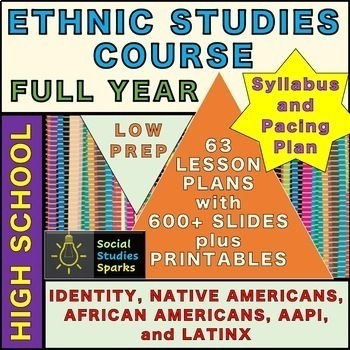Ethnic Studies Year Course - High School Curriculum - Low Prep - Identity Intro
- Zip
- Easel Activity
- Easel Assessment
What educators are saying
Products in this Bundle (5)
Bonus
Description
At last, a comprehensive, and compelling Ethnic Studies curriculum! LOW PREP (print and go) – each unit includes lesson plans, slides with activities, PDF handouts, and formative and summative assessments. There's even an editable Syllabus and Pacing Planner! Use for Ethnic Studies and History, or to provide context for English topics. High School resource that can be used for digital learning. These units help you address complex issues with sensitivity and respect.
Teaching Ethnic Studies is both incredibly rewarding and incredibly difficult. Teachers often have to piece together hard-to-find resources for electives while teaching multiple preps. This resource is the result of years of experience and months of research. I’ve done the intensive prep so that you can concentrate on teaching!
Teacher directions include differentiation strategies to help meet individual student needs. Student directions are clear and concise, and the lessons include numerous graphic organizers that provide scaffolding. The multiple-choice test is editable so assessments can be differentiated, as are the slide text boxes that have definitions, explanations, and questions. There are even slide templates so you can customize the lessons!
*For copyright reasons, other materials in this resource are NOT editable (the editable components are listed above).*
In an introductory unit, students examine facets of cultural identity. Each of the four ethnic group units has five sections (plus some bonus sections). Take your students on an interactive journey that begins with an exploration of a theme, such as identity, continues with terms and concepts, covers history and current issues, then addresses social justice. Lessons are organized in a step-by-step manner that enables students to comprehend interconnected and complex concepts.
The course length is 30 to 44 weeks if every lesson is used. The variation is mainly due to the option of doing assignments as classwork or homework. I have made the Ethnic Studies units thorough and extensive in order to meet diverse needs. You may need to pick and choose lessons to fit within your time frame. The editable Syllabus and Pacing Planner are designed to help you make those choices and individualize your course.
IN TOTAL, THERE ARE:
- 63 PDF Lessons Plans
- 600+ PowerPoint Slides
- 174 pages of PDF Handouts
EACH UNIT INCLUDES:
- An overview that includes information about addressing sensitive topics
- PDF lesson plans with objectives, essential questions, standards, and differentiation
- Lesson plans also include easy, step-by-step, procedures
- PowerPoint slides with multiple activities and slide templates so you can customize the resources
- Lesson plan procedures are also in the slide notes
- PDF Handouts with clear directions, including:
- Terms and Definitions handouts in editable Word and PDF versions
- Draw It! activities to review key terms
- Multiple-choice tests in editable Word and Easel versions with Keys
- Close Watching: Video Response Notes
- Close Reading Annotation cards
- Links for readings on many, many topics.
- Reading questions
- Historical Timeline handouts
- Living Timeline activities with event cards
- Illustrated Timeline activities on with accompanying slides
- Infographic activities about current issues
- Mini-debate activities on engaging topics with Rubrics
- Essay Organizers for five-paragraph essays
- Reflections in which students write about the most important things that they learned
- Optional suggestions for readings and activities from A Different Mirror for Young People by Ronald Takaki
The slides can be imported into Google Slides, Nearpod, or Pear Deck to enhance online learning and/or to add activities such as discussions and polls.
In the Exploring Cultural Identity unit, students examine cultural identity terms and concepts that include race, ethnicity, nationality, social class, religion, language, ability, sex, gender, and sexual orientation.
The Native American unit includes terms and concepts that are taught in the context of the time period in which they occurred, such as: Paleo-Americans, Beringia, Native Americans, indigenous, tribe, nation, country or state, sovereignty, treaty, removal, reservation, assimilation, allotment, re-organization, termination, relocation, self-determination, and self-government.
The African American unit includes these primary terms and concepts: privilege, intersectionality, oppression, race, racism, systemic racism, interpersonal racism, overt racism, microaggressions, colorism, internalized racism, narrative, master/dominant narratives, counter-narratives, and counter-storytelling.
The Asian Pacific American unit includes these primary terms and concepts related to intolerance: stereotyping, prejudice, bigotry, racism, xenophobia, discrimination, scapegoating, hate crimes, genocide, and bystander. The unit also addresses Islamophobia and anti-Semitism. The Holocaust is studied as an example of the escalation of intolerance.
The Latinx American unit includes these primary terms and concepts: equality, equity, justice, agency, bias, cognitive bias, explicit bias, implicit bias, confirmation bias, and disconfirmation bias.
IMPORTANT NOTE: While teaching online during the pandemic, I began to utilize short video clips for instruction. They were particularly impactful in Ethnic Studies, due to their visceral nature. Because of their effectiveness, I have incorporated them into my curriculum, so this resource includes links to short videos. Thus, I suggest that you consider your ability to show videos to students when making a decision about purchasing this resource.
Click her to see my Ethnic Studies Course with an introductory LGBTQ+ unit (rather than a Cultural Identity unit).
You can also save big with a mega bundle: Social Justice Thematic Units—Infuse in History, Pair with Literature in English
I have taught various iterations of this content for over 25 years and this hard-to-find material has evolved as both society and I have evolved. The topic and content have proven to be deeply engaging and memorable for my students.
I care about these issues, and I would love to hear any questions or suggestions that you have. If you find the resource useful, I would appreciate it if you would write a review—you’ll receive TPT credits to apply to future purchases! Thank you.





